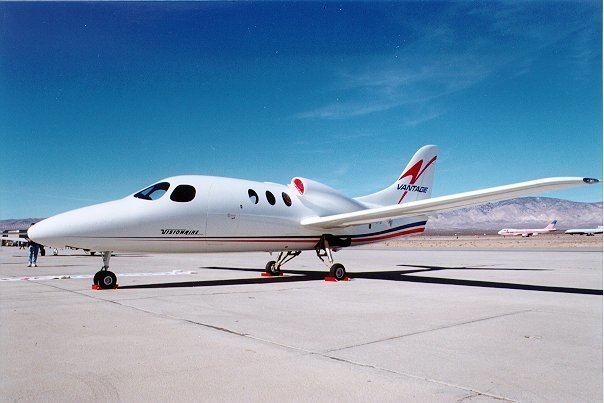Top speed 694 km/h Length 13 m First flight November 16, 1996 | Wingspan 14 m Number built 1 Manufacturer VisionAire Corporation | |
 | ||
Visionaire vantage business jet
The VisionAire VA-10 Vantage is a prototype single-engined light business-jet (or "very light jet") designed and developed by the American company VisionAire Jets Corporation. Originally planned for production in the late 1990s, the original VisionAire Corporation failed in 2003. The project was acquired by Eviation Jets, which planned to produce it as the redesigned EV-20 Vantage Jet. Eviation also failed, and in 2012 the design was relaunched by a revived VisionAire under its original design.
Contents
- Visionaire vantage business jet
- Design and development
- Eviation EV 20 Vantage Jet
- Return to VisionAire
- Specifications VisionAire Vantage
- References
Design and development
The Vantage is currently being developed by VisionAire Jets, LLC, a successor company to VisionAire Corporation, founded in 1988, to fill a perceived gap in the light aircraft market between high performance piston-engined aircraft and twin-engined executive jets. The Vantage differed from contemporary executive jets in that it was powered by a single engine, a Pratt & Whitney Canada JT15D turbofan buried in the rear fuselage, fed by twin air-inlets above the fuselage. It was of all-composite construction, and its wing was forward swept to reduce drag and to allow an unobstructed cabin by mounting the wing spar behind the cabin. It was planned to sell the Vantage for $1.65 million, compared with $3.3 million for the Cessna CitationJet.
The first prototype, a proof-of-concept aircraft intended to confirm the design's handling, was designed and built by Burt Rutan's Scaled Composites at Mojave, California. It made its maiden flight on November 16, 1996. Flight testing revealed several handling and aerodynamic problems, which resulted in a redesign of the aircraft in December 1998.
Delays to the program continued, while costs mounted, and in January 2003, with the company having already spent $110 million, requiring another $125 million to complete certification and owing $35 million, a Federal Judge ordered VisionAire liquidated to pay its debts. The Vantage design was purchased by Eviation, for use as a basis for the twin-engined EV-20 Vantage Jet design.
The Vantage Proof-of-Concept (POC) aircraft is currently located at the VisionAire Jets facility at the Hickory Airport, Hickory North Carolina.
Eviation EV-20 Vantage Jet
Following the purchase of the Vantage by Eviation Jets, the proposed EV-20 was envisioned as a twin-engine design with two Williams FJ44-1AP turbofan engines, with a projected cruise speed of 424 knots (785.2 km/h) at 36,000 feet (10,972.8 m) with an approximate range of 1,300 nautical miles (2,407.6 km). In the executive configuration it would have provided room for eight passengers, or ten commuter passengers. It would incorporate Garmin G1000 avionics, and would be made entirely from composite materials. kBky 2006, initial review of the EV-20 design were completed and construction of a prototype aircraft was expected to begin, utilizing an outside fabricator for construction of the prototype.
Return to VisionAire
The redesign of the Vantage from a single- to a twin-engine design proved troublesome; the company failed to progress with the development of the type, and in 2012 the EV-20 was repurchased by VisionAire; the aircraft's design was returned to a single-engined configuration, and VisionAire stated in early 2013 that they planned to construct the Vantage in a factory in Newton, North Carolina, with the prototype scheduled to fly in 2014. However, at the end of 2015 no further progress has been announced; latest update on the company's website is dated March 2013.
Specifications (VisionAire Vantage)
Data from Jane's All The World's Aircraft 2003–2004
General characteristics
Performance
